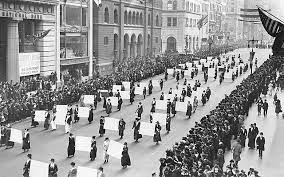On January 12, 1915, a pivotal moment in the history of women's rights unfolded as the Women's Suffrage Bill was introduced in the British Parliament. This legislation marked a significant step forward in the long and arduous struggle for women to gain the right to vote in the United Kingdom. The Women's Suffrage Bill of 1915 aimed to grant voting rights to a specific group of women - those who were over the age of 30 and met certain property qualifications. While this may seem restrictive by modern standards, at the time, it represented a groundbreaking departure from the status quo. The bill was a result of years of relentless activism and campaigning by suffragists and suffragettes who fought tirelessly for equal political representation. The suffrage movement had gained momentum in the late 19th and early 20th centuries, with women organizing and advocating for their right to participate in the democratic process. The bill presented on January 12, 1915, was a response to the escalating pressure from suffragist groups, notably the suffragettes associated with the Women's Social and Political Union (WSPU), led by Emmeline Pankhurst and her daughter Christabel Pankhurst. The suffragettes had adopted more militant tactics, including hunger strikes and acts of civil disobedience, to draw attention to their cause. Their efforts had not gone unnoticed, and the introduction of the Women's Suffrage Bill was, in part, a response to the growing demand for women's enfranchisement. The bill faced its fair share of challenges in Parliament, with opponents arguing against the extension of voting rights to women. Traditional gender norms and societal attitudes towards women's roles were deeply ingrained, and many politicians hesitated to embrace such a radical change. However, the suffrage movement had gained widespread public support, and the pressure for reform was palpable. Despite the progress represented by the Women's Suffrage Bill, it fell short of achieving universal suffrage for women. The age and property qualifications meant that a significant portion of the female population remained excluded from the voting process. Nevertheless, the bill marked a crucial turning point and set the stage for further advancements in women's suffrage. The Women's Suffrage Bill of 1915 was not immediately successful, as it faced resistance and failed to pass in Parliament. However, it laid the groundwork for future legislative efforts and contributed to the eventual success of the women's suffrage movement. Women in the UK did not gain full voting rights on equal terms with men until the Representation of the People Act 1928, which granted suffrage to all women over the age of 21. In retrospect, January 12, 1915, stands as a moment of both triumph and challenge in the pursuit of women's rights. The Women's Suffrage Bill symbolizes the courage and determination of the suffragists who paved the way for greater gender equality in the political sphere, ultimately shaping the course of history for women's rights in the United Kingdom.
12 January 1915 Women’s Suffrage Bill
